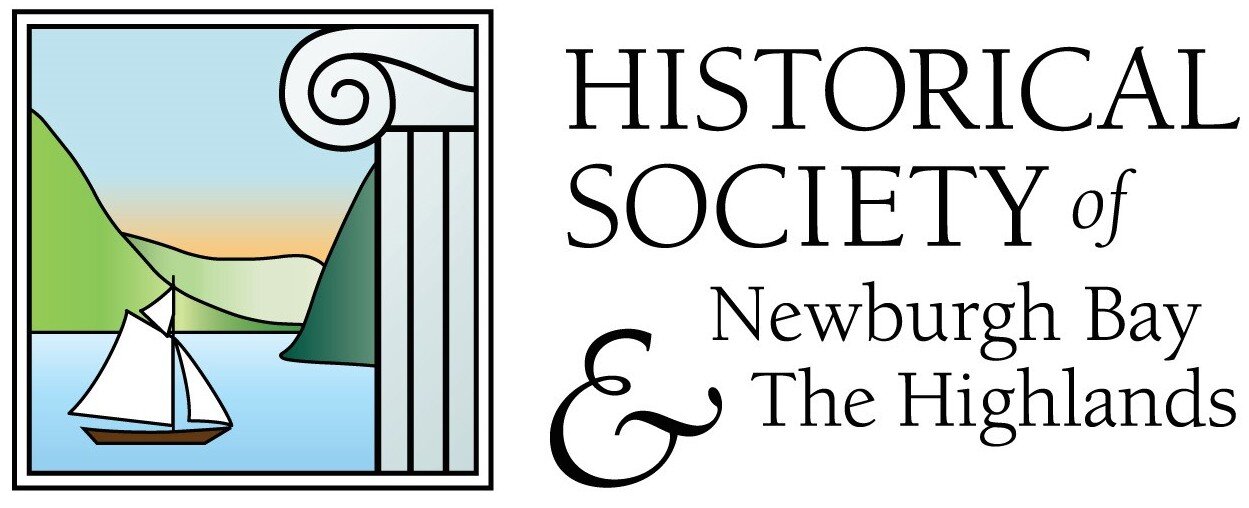Excerpt: The Rev. John Brown, D.D.
Of all Newburgh’s galaxy of brilliant and distinguished clergy-men of other days, perhaps the most outstanding was Dr. John Brown, for many years rector of St. George’s. He occupied its pulpit from 1815 to 1878 and was both beloved and admired. He was a man of great activity and business ability, and his sagacity and acumen gave him an influence in the village far beyond the interests of his immediate parish.
“Quality Row,” First and Liberty Streets, Newburgh, 1913.
He owned the land on which were erected the quaint and beautiful houses always know as “Quality Row,” and lived in one of those houses for many years. He died in 1884, during the first year of our Society’s existence.
The foregoing story of the shade trees, the original manuscript of which, entirely in Dr. Brown’s handwriting, has for years been in the present writer’s large collection of documents relating to early Newburgh, reflects an attitude toward trees only too prevalent today, and is of tremendous interest and value as a picture by a contemporary witness of a part of the city of which clarity and bring out its points of interest:
It is undated, but from internal evidence we learn that it was written in 1866, during the first year of City government. Hon. George Clark was Mayor, and the “City Fathers” against whom the good doctor rails were: Daniel A. Rheutan, Jon Lomas, James Bigler, and James Whitehill. Charles B. Royce was City Clerk. The Chairman of the Committee on Streets was Alderman Edson Hubbard Clark, representing the Third Ward. He operated the iron foundry of Clark & Kimball, on Washington Street, near Liberty, and was a close neighbor of Dr. Brown, residing in a house still standing at 252 Liberty Street. It is strange to hear of him starting a movement to destroy trees, as we are told by Hon. Daniel Coutant that Mr. Clark was famed as a pomologist, having in his yard one tree of which he was especially proud, as he had grafted a life member of the United States Pomological Society and a close friend of Charles Downing.
This essay first appeared in the Historical Society’s 1929 annual publication.
We glean from the story the following facts not recorded in any existing history of Newburgh:
That as late as 1828 Grand Street and Liberty Street were considered suburban, and that all efforts at city government and “public works” were confined to the section “below the hill.” Smith Street and Montgomery Street must have been flourishing residential streets,-a complete reversal from early days of settlement, when the residential center was upper Liberty Street.
That the width of sidewalks “on the hill” was determined in 1827, by the then Street Commissioner, who fixed it at six feet, to the annoyance of the “inhabitants.” (The Street Commissioner at this time was Thomas Philips, Junior. He had held that position, at a salary of $200 per annum, from 1826 to 1827, and retained it after his re-election on May 1827, this being his last term on the Village Board of Trustees, of which he became a member in 1823. The previous year, 1826, he had been a member of Newburgh committee to urge upon the Sate the construction of a macadamized road from Buffalo to Newburgh. In 1810 he was a member of the first Hook and Ladder company of the Village.)
That Dr. Brown, and his neighbors, then proceeded to plant shade trees along the edge of these six-foot sidewalks.
That some few years later, the city government still neglecting to improve this suburban district, the neighbors formed themselves into what they called the “Improvement Party” and personally undertook to make Grand Street “passable” by levelling it.
That at this time, on their own responsibility, they fixed the width of rand Street’s sidewalks at twelve feet, thus leaving their trees, now well developed, in the middle of the walk. That in 1866 the new City Government discovered that the trees, so placed, were an incumbrance, and proceeded to cut them down.
And finally, that the term “Quality Row” was apparently applied in sarcasm to the homes of Dr. Brown and his neighbors by those who failed to share their consternation over the loss of their trees.
This may also be a suitable time to put on record certain facts regarding “Quality Row” and Dr. Brown’s acquisition of the land on which it stands. […]
-End of Preview-
The above essay was first published in the Historical Society’s 1929 annual publication.


